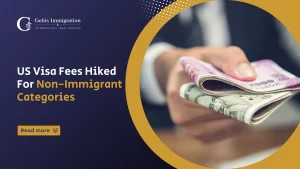In today’s globalised world, the United States remains a top destination for skilled professionals worldwide, and the H1B visa is their coveted path to U.S. employment. This article explores H1B visas, focusing on a crucial aspect: staying on one without a job.
The H1B visa program is renowned for facilitating the entry of foreign workers into specialised fields in the United States, offering both job opportunities and a route to permanent residency.
Common Concerns about Staying on an H1B Visa Without a Job
Job loss on an H1B visa can lead to worries about legal status, potential overstay issues, and unemployment challenges in the U.S.
This article addresses the concerns of H1B visa holders facing job loss, providing insights into the 60-day grace period, legal status maintenance options, and guidance for navigating this complex situation, empowering you to make informed decisions.
Understanding the H1B Visa
The H1B visa is a prized non-immigrant visa in the U.S., allowing employers to hire skilled foreign workers for specialized roles. It’s sought after by global professionals seeking temporary employment in fields like technology, engineering, healthcare, and finance.
The H1B visa is tailored for individuals pursuing specialised employment in technology, engineering, healthcare, and finance. Applicants need a job offer from a U.S. employer willing to sponsor them to qualify. Employers must demonstrate the role’s need for specialised skills not readily found in the local workforce.
What Is The Eligibility Requirements of H-1B Visa
For H-1B, both employers and employees must meet specific criteria:
Employer Eligibility: The employer must be a legitimate U.S. entity offering a speciality occupation job, often requiring at least a bachelor’s degree in a relevant field.
Employee Eligibility: The employee should possess the required qualifications, including education, experience, and credentials. A valid job offer from the sponsoring employer is essential.
Labour Condition Application (LCA): Employers must file an LCA with the U.S. Department of Labor, certifying payment of the prevailing wage for the job in the specified location.
Employment Authorization and Duration for H-1B Visa
An approved H1B visa allows the holder to work in the U.S. for a specified period, typically up to three years initially and extendable to six years. The visa’s duration aligns with the employment contract. H1B visa holders work exclusively for their sponsoring employer in the designated role.
The Challenge of Staying on an H1B Visa Without a Job
The H1B visa can be a complex journey, particularly when confronted with the prospect of remaining on this visa without employment. The intricacies of this challenging scenario encompassing the critical 60-day grace period, the implications of job loss on visa status, and the various scenarios and concerns frequently encountered by H1B visa holders.
Exploring the 60-Day Grace Period
One of the pivotal aspects for H1B visa holders contending with job loss is the 60-day grace period provided by the U.S. government. This period grants individuals the legal right to stay in the country, allowing them to secure new employment or explore alternative visa options. It is imperative for those navigating this transition to grasp the rules and constraints associated with this grace period.
Implications of Job Loss on Visa Status
Losing employment while holding an H1B visa can have far-reaching implications for one’s visa status. It can raise concerns surrounding the maintenance of legal status, the possibility of overstay issues, and the potential impact on future visa applications or endeavours to attain permanent residency through a green card. Examining these consequences and seeking informed guidance becomes paramount for H1B visa holders confronted with such circumstances.
Common Scenarios and Concerns in H-1B visa
H1B visa holders facing job loss often find themselves in diverse scenarios, each presenting its unique array of concerns. These scenarios can encompass job terminations, layoffs, or voluntary job changes, each requiring careful consideration. Addressing common concerns, including H1B visa transfers, transitions to different visa categories, or pursuing alternative immigration pathways, becomes essential for individuals navigating this multifaceted terrain.
Sponsorship Employment US Visa.
For those seeking employment in the United States, sponsorship through various visa categories is a common route. Different options are available to foreign workers, including the process and considerations associated with each choice.
Eligibility Criteria: To undertake an H1B visa transfer, the individual must hold an H1B visa and secure a new job offer from a U.S. employer.
Process and Timelines: The process involves the new employer filing an H1B petition on behalf of the employee. Timelines can vary but typically take several months.
Pros and Cons: This option allows for a smooth transition to a new job and employer in the U.S. However, it may require walking through bureaucratic complexities and potential uncertainties in the transfer process.
Exploring Other Visa Categories
For those seeking alternatives or facing unique circumstances, various visa categories are available:
H4 Dependent Visa: Designed for spouses and children of H1B visa holders, H4 visas allow dependents to reside in the U.S. While they can’t work by default, there are some recent exceptions.
F1 Student Visa: Ideal for individuals pursuing higher education, F1 visas allow for part-time on-campus employment and Optional Practical Training (OPT) for work experience.
B1/B2 Tourist Visa: While primarily for tourism, these visas may permit limited business-related activities. Employment, however, is generally not allowed.
Considering Alternative Paths
For those looking to establish a long-term presence in the United States, exploring alternative paths to permanent residency is essential:
Adjustment of Status (Green Card): A pathway to lawful permanent residency, the green card is a coveted status. Eligibility criteria often include family sponsorship or employer sponsorship through labour certification.
Employer-Sponsored Green Card: Companies can sponsor employees for green cards, provided they demonstrate a genuine need and undertake the labour certification process.
Marriage-Based Green Card: Marriage to a U.S. citizen or permanent resident can pave the way to a green card, offering a direct path to permanent residency.
How Many Days Can We Stay in the USA on an H1B Visa Without a Job?
Understanding the duration of stay on an H1B visa without employment is crucial for visa holders facing job loss. Let’s understand insights into the 60-day grace period, the associated rules and restrictions, the importance of maintaining legal status, and the potential consequences of overstaying.
Overview of the 60-Day Grace Period
The U.S. government provides a valuable safety net for H1B visa holders who lose their jobs. This is known as the 60-day grace period. During these 60 days, individuals can legally remain in the United States, even without employment. This period offers a valuable opportunity to secure new employment, change visa status, or make necessary arrangements.
Rules and Restrictions
While the 60-day grace period offers flexibility, there are important rules to follow:
- During this period, you can only work if you secure new employment with an employer willing to sponsor your H1B visa.
- Changing employers or transferring your H1B visa to a new employer within this timeframe is allowed, and you can begin work as soon as the new petition is filed.
- You cannot leave the United States and re-enter on your existing H1B visa during the grace period.
- You must secure new employment or take appropriate action within 60 days to avoid overstaying your visa.
Maintaining Legal Status
Maintaining legal status during the 60-day grace period is crucial for your future immigration prospects. You must remain in the United States and ensure your actions align with the visa regulations. Seeking legal advice and guidance during this period is advisable to make informed decisions that safeguard your status.
Consequences of Overstaying
Overstaying your visa can have serious consequences, including:
Ineligibility for future U.S. visas or visa extensions.
Negative impacts on your immigration record, potentially affecting future green card applications.
Deportation or removal proceedings can have long-lasting effects on your ability to return to the United States.
Understanding the 60-day grace period, its rules and restrictions, and the importance of maintaining legal status is essential for H1B visa holders facing job loss. It offers a lifeline during challenging times, but careful consideration is required to protect your immigration status and future opportunities in the United States.
Tips for Staying on an H1B Visa Without a Job
The challenging scenario of staying on an H1B visa without employment requires strategic planning and proactive measures. Here are some valuable tips to consider:
- Legal Consultation
Seeking legal advice is paramount when facing job loss on an H1B visa. An immigration attorney can guide your situation, the 60-day grace period, and the best action to maintain your legal status. Their expertise can help you make informed decisions and avoid potential pitfalls. - Job Search and Networking
Initiate an active job search immediately after losing your job. Leverage your professional network, including former colleagues and contacts in your industry. Attend networking events, job fairs, and industry-specific conferences to explore employment opportunities. Your goal should be to secure a new job offer within the 60-day grace period. - Exploring Educational Opportunities
Consider enrolling in educational programs or courses that enhance your skills and qualifications. This demonstrates your commitment to professional growth and provides an avenue for maintaining legal status through Optional Practical Training (OPT) or Curricular Practical Training (CPT) if you are eligible. Explore educational institutions and programs that align with your career goals. - Planning for the Future
Use this transitional period to assess your long-term plans in the United States. If you intend to continue working in the country, consider alternative visa options, such as an O-1 visa for individuals with extraordinary abilities or an employment-based green card. Long-term planning can help you secure a stable immigration status. - Stay Informed
Keep yourself informed about changes in immigration laws, policies, and visa regulations. Government rules can evolve, impacting your options and requirements. Staying up-to-date with immigration news and regulations is crucial for making informed decisions. - Financial Planning
Manage your finances prudently during this period. Job loss can lead to financial challenges, so create a budget, minimise unnecessary expenses, and explore ways to ensure financial stability during your job search. - Maintain a Positive Attitude
Maintain a positive mindset throughout your job search and visa transition. Job loss can be stressful, but optimism, resilience, and a proactive approach can be your strongest assets in finding new opportunities and securing your immigration status.




